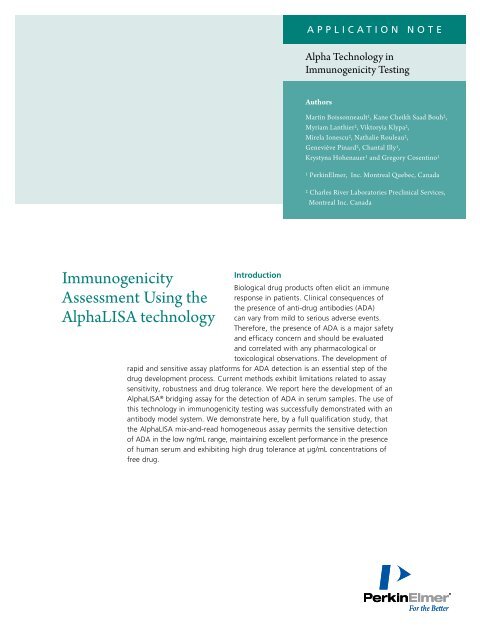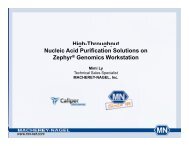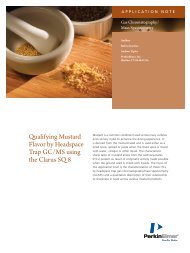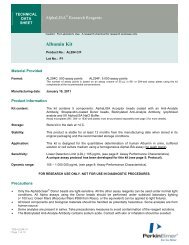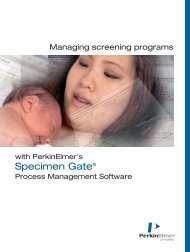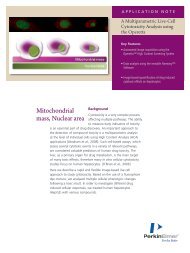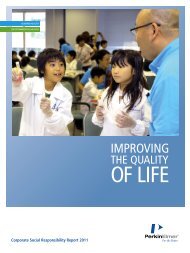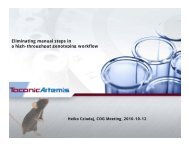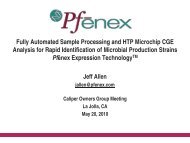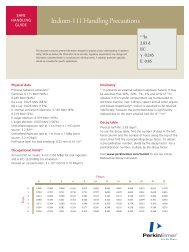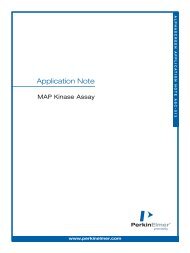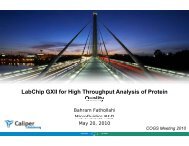Immunogenicity Assessment Using the AlphaLISA ... - PerkinElmer
Immunogenicity Assessment Using the AlphaLISA ... - PerkinElmer
Immunogenicity Assessment Using the AlphaLISA ... - PerkinElmer
You also want an ePaper? Increase the reach of your titles
YUMPU automatically turns print PDFs into web optimized ePapers that Google loves.
application Note<br />
Alpha Technology in<br />
<strong>Immunogenicity</strong> Testing<br />
Authors<br />
Martin Boissonneault 1 , Kane Cheikh Saad Bouh 2 ,<br />
Myriam Lanthier 2 , Viktoryia Klypa 2 ,<br />
Mirela Ionescu 2 , Nathalie Rouleau 2 ,<br />
Geneviève Pinard 2 , Chantal Illy 1 ,<br />
Krystyna Hohenauer 1 and Gregory Cosentino 1<br />
1 <strong>PerkinElmer</strong>, Inc. Montreal Quebec, Canada<br />
2 Charles River Laboratories Preclinical Services,<br />
Montreal Inc. Canada<br />
<strong>Immunogenicity</strong><br />
<strong>Assessment</strong> <strong>Using</strong> <strong>the</strong><br />
<strong>AlphaLISA</strong> technology<br />
Introduction<br />
Biological drug products often elicit an immune<br />
response in patients. Clinical consequences of<br />
<strong>the</strong> presence of anti-drug antibodies (ADA)<br />
can vary from mild to serious adverse events.<br />
Therefore, <strong>the</strong> presence of ADA is a major safety<br />
and efficacy concern and should be evaluated<br />
and correlated with any pharmacological or<br />
toxicological observations. The development of<br />
rapid and sensitive assay platforms for ADA detection is an essential step of <strong>the</strong><br />
drug development process. Current methods exhibit limitations related to assay<br />
sensitivity, robustness and drug tolerance. We report here <strong>the</strong> development of an<br />
<strong>AlphaLISA</strong> ® bridging assay for <strong>the</strong> detection of ADA in serum samples. The use of<br />
this technology in immunogenicity testing was successfully demonstrated with an<br />
antibody model system. We demonstrate here, by a full qualification study, that<br />
<strong>the</strong> <strong>AlphaLISA</strong> mix-and-read homogeneous assay permits <strong>the</strong> sensitive detection<br />
of ADA in <strong>the</strong> low ng/mL range, maintaining excellent performance in <strong>the</strong> presence<br />
of human serum and exhibiting high drug tolerance at μg/mL concentrations of<br />
free drug.
Materials and Methods<br />
Materials<br />
Mouse monoclonal IgG2b antibody (<strong>the</strong> drug) was purchased<br />
from AbD Serotec (Cat # MCA2472). The ADA<br />
positive control antibody (PC) was a polyclonal goat antimouse<br />
IgG (mouse IgG) antibody obtained from Jackson<br />
ImmunoResearch (Cat # 115-005-062). The matrix consisted<br />
of a pooled normal human serum (PNHS) and individual lots<br />
of normal human serum purchased from Bioreclamation<br />
(Cat # HMSRM). <strong>AlphaLISA</strong> Acceptor beads and streptavidincoated<br />
Donor beads (SA-Donor) were from <strong>PerkinElmer</strong><br />
(Cat # 6772002 and Cat # 6760002, respectively). The<br />
ChromaLink biotinylating reagent was obtained from<br />
SoluLink (Cat # B1001-105). Zeba Spin desalting columns<br />
were from Thermo Scientific (Cat # 89883). OptiPlate -96<br />
white opaque 96-well microplates were from <strong>PerkinElmer</strong><br />
(Cat # 6005290).<br />
<strong>AlphaLISA</strong> ADA Assay<br />
The <strong>AlphaLISA</strong> ADA assay was performed as follows:<br />
In an OptiPlate-96 microplate, all samples (PC, blank and<br />
test samples) were diluted to 10% with acetic acid (600 mM)<br />
and <strong>the</strong>n incubated for 60 minutes on a plate shaker set<br />
at 200 rpm in an incubator set at 23 ˚C. Then 50 μL of<br />
neutralization buffer containing 4 nM of biotinylated drug<br />
and 80 μg/mL of <strong>AlphaLISA</strong> drug-Acceptor beads was added<br />
to <strong>the</strong> plate. The plate was <strong>the</strong>n incubated for 60 minutes<br />
on a plate shaker set at 200 rpm, in an incubator set at<br />
23 ˚C. Finally 100 μL of SA-Donor beads (40 μg/mL) diluted<br />
in assay buffer was added to <strong>the</strong> plate which was <strong>the</strong>n<br />
incubated for 60 minutes on a plate shaker set at 200 rpm,<br />
in an incubator set at 23 ˚C. After this incubation, <strong>the</strong> plate<br />
was read using <strong>the</strong> EnVision ® 2103 Multilabel Plate Reader<br />
and <strong>the</strong> <strong>AlphaLISA</strong> relative counts were measured.<br />
The assay buffer was composed of 50 mM Tris-HCl pH 7.75,<br />
150 mM NaCl, 0.1% Tween-20, 0.5% BSA, and 0.05%<br />
bovine g-globulin. The neutralization buffer was prepared by<br />
mixing <strong>the</strong> assay buffer with 1 M Tris-HCl pH 9.5 at a ratio<br />
of 30:70 (v/v).<br />
Preparation of Drug-conjugated <strong>AlphaLISA</strong> Acceptor<br />
Beads<br />
Drug immobilization on <strong>the</strong> <strong>AlphaLISA</strong> Acceptor beads was<br />
performed using a simple standard aldehyde group coupling<br />
procedure. Briefly, 0.025 mg of drug antibody, 0.0625% of<br />
Tween-20, 1.25 mg of <strong>AlphaLISA</strong> beads and 1.25 mg/mL<br />
of NaBH 3CN were mixed toge<strong>the</strong>r. The reaction volume was<br />
completed to 0.05 mL with 130 mM Na Phosphate pH 8.0<br />
and <strong>the</strong> reaction was incubated for 18 hours at 37 ˚C. The<br />
reaction was stopped by <strong>the</strong> addition of 2.5 µL of a 65 mg/mL<br />
CMO solution and incubation for one hour at 37 ˚C. Beads<br />
were <strong>the</strong>n washed twice by centrifugation for 15 minutes<br />
(14,000 rpm/4 ˚C) and <strong>the</strong> bead pellet was resuspended in<br />
0.5 mL of 100 mM Tris pH 8.0. After a third centrifugation<br />
step, <strong>the</strong> beads were resuspended at 5 mg/mL in PBS pH<br />
7.2 containing 0.05% Proclin-300.<br />
Drug Biotinylation<br />
Drug biotinylation was performed with <strong>the</strong> ChromaLink<br />
biotinylating reagent using standard biotinylation and<br />
purification procedures. Briefly, 0.025 mg of antibody<br />
and 1.9 µL of biotinylating reagent (2 mg/mL) were mixed<br />
toge<strong>the</strong>r at a 30:1 molar biotin/antibody ratio. The reaction<br />
volume was completed to 0.05 mL with PBS pH 7.4 and <strong>the</strong><br />
reaction was incubated for 2 hours at 23 ˚C. Purification of<br />
<strong>the</strong> biotinylated antibody was performed using a Zeba 0.5 mL<br />
desalting column. The ratio of biotinylation of <strong>the</strong> final<br />
product and <strong>the</strong> protein recovery were determined from<br />
absorbance readings at 354 nm and 280 nm, respectively.<br />
Figure 1. <strong>AlphaLISA</strong> assay protocol.<br />
Assay Configuration<br />
The <strong>AlphaLISA</strong> ADA detection assay was developed using<br />
a bridging assay configuration. The assay is dependent on<br />
bivalent binding of anti-drug antibodies to biotinylated drug<br />
molecules captured by <strong>the</strong> Streptavidin (SA)-Donor beads<br />
and drug antibodies immobilized on <strong>the</strong> Acceptor beads.<br />
This bridging assay format eliminates <strong>the</strong> need for species–<br />
specific secondary antibodies. The presence of anti-drug<br />
antibodies will bridge <strong>the</strong> two drug molecules and, consequently,<br />
bring <strong>the</strong> two beads in close proximity. Laser<br />
excitation of <strong>the</strong> Donor beads will provoke <strong>the</strong> release of<br />
singlet oxygen molecules that trigger a cascade of energy<br />
transfer in surrounding Acceptor beads, thus resulting in a<br />
time-delayed sharp peak of light emission at 615 nm.<br />
Acid induced dissociation of immune complexes was implemented<br />
during sample preparation in order to improve drug<br />
tolerance.<br />
2
Excitation<br />
680 nm<br />
Biotinylated<br />
Drug IgG<br />
Emission<br />
615 nm<br />
Twelve replicates of Blank prepared with <strong>the</strong> pooled normal<br />
human serum (PNHS) were included on each plate. The<br />
mean relative counts value of <strong>the</strong> 12 replicates, a correction<br />
factor (CF) and <strong>the</strong> overall mean relative counts value of<br />
PNHS were determined for each occasion. The mean CF<br />
value was used as normalization factor for all assays in<br />
Qualification. The plate specific cut-point (PSCP) was<br />
calculated by multiplying <strong>the</strong> mean CF value with <strong>the</strong><br />
mean relative counts value of PNHS (Blank wells, n = 12).<br />
Streptavidin-coated<br />
Alpha Donor Bead<br />
Anti-Drug<br />
IgG (ADA)<br />
Figure 2. <strong>AlphaLISA</strong> bridging assay configuration.<br />
Drug IgG-coated<br />
<strong>AlphaLISA</strong> Acceptor Bead<br />
Results<br />
The <strong>AlphaLISA</strong> qualification study was performed at Charles<br />
River Laboratories Preclinical Services Montreal Inc. (Quebec,<br />
Canada) using a standardized approach for qualification of<br />
immunogenicity assays. The analytical method was subjected<br />
to <strong>the</strong> following experimental assessments to ensure it was<br />
suitable for its intended use: determination of <strong>the</strong> screening<br />
cut-point (CP), determination of <strong>the</strong> confirmatory assay<br />
cut-point (CCP), intra- and inter-assay precision, sensitivity,<br />
specificity, selectivity, drug tolerance and prozone effect.<br />
For this study, a model system was used in which <strong>the</strong> drug is<br />
mimicked by a monoclonal mouse IgG. The Positive Control<br />
(PC) used in this procedure is an affinity purified Goat antimouse<br />
IgG antibody prepared at different concentration<br />
levels in neat pooled normal human serum (PNHS).<br />
Screening cut-point<br />
The screening cut-point (CP) was used to determine <strong>the</strong><br />
threshold for identifying samples as negative (below <strong>the</strong><br />
CP) or potential positive (equal or above <strong>the</strong> CP) for <strong>the</strong><br />
presence of anti-drug antibodies. Fifty individual lots of<br />
normal human serum (25 males and 25 females) were<br />
analyzed each in duplicate on a total of 4 occasions<br />
performed by two analysts using a balanced design to collect<br />
mean relative counts values. On each occasion, <strong>the</strong> average<br />
values of <strong>the</strong> two corresponding relative counts measurements<br />
were used in <strong>the</strong> data analysis.<br />
The normal distribution was assumed for <strong>the</strong> CP determination.<br />
The CP value for each occasion was determined to be <strong>the</strong><br />
mean relative counts value of <strong>the</strong> individual serum lots plus<br />
1.645 x SD, which represents <strong>the</strong> 95th percentile of a normal<br />
distribution. All serum lots with values higher than <strong>the</strong> 95th<br />
percentile on more than 50% of <strong>the</strong> CP determination occasions<br />
were removed from <strong>the</strong> calculation. They were defined as<br />
true or false positives based on <strong>the</strong> confirmatory assay results<br />
(see next section). The final CP value was calculated in <strong>the</strong><br />
second iteration, using <strong>the</strong> remaining individual serum lots.<br />
Table 1. Screening cut-point determination. The CP was<br />
determined using 50 individual lots of PNHS, analyzed each<br />
in duplicate on a total of four occasions. The CP was calculated<br />
as <strong>the</strong> mean counts plus 1.645 x SD. Two samples were<br />
removed for <strong>the</strong> second iteration.<br />
1st iteration<br />
2nd iteration<br />
Screening Cut-Point Screening Cut-Point<br />
Mean (counts) 532 509<br />
n 50 48<br />
SD 127 55<br />
Cut-Point (counts) 741 600<br />
Mean Blank (counts) 470 470<br />
Correction Factor 1.57 1.28<br />
Two human serum lots were identified as outliers, since <strong>the</strong>ir<br />
mean relative count values were superior to <strong>the</strong> CP on all<br />
four occasions and were excluded from <strong>the</strong> final CP calculation.<br />
These lots were analyzed in <strong>the</strong> confirmatory assay and<br />
one lot was confirmed positive (true positive), whereas <strong>the</strong><br />
o<strong>the</strong>r one was confirmed negative (false positive). The mean<br />
CF, defined at 1.280, was used in <strong>the</strong> qualification. The<br />
PSCP for each assay plate was determined in all subsequent<br />
experiments using <strong>the</strong> following formula:<br />
PSCP = Mean Blank Relative Counts (RC)<br />
(after removal of maximum 2 outliers) x 1.280<br />
Confirmatory cut-point<br />
The confirmatory assay was validated to determine <strong>the</strong><br />
CCP (% signal inhibition) which was used to verify whe<strong>the</strong>r<br />
samples identified as potentially reactive in <strong>the</strong> anti-drug<br />
antibody screening assay are confirmed positive or negative.<br />
CCP determination was performed in 4 occasions, by two<br />
analysts, using a balanced assay design. Fifty individual lots<br />
of normal human serum (i.e. same lots tested for CP in <strong>the</strong><br />
previous section) were spiked with <strong>the</strong> drug and <strong>the</strong>n<br />
analyzed in duplicates. The CCP blank and PCs were loaded<br />
only in one plate among <strong>the</strong> 4 plates. Two PC levels (LPC<br />
and HPC), Blank (PNHS) and <strong>the</strong> individual lots of human<br />
serum (same lots as used for <strong>the</strong> CP determination), were<br />
3
spiked with <strong>the</strong> drug at a final concentration of 25 μg/mL<br />
(spiked samples). The overall mean of PC and blank samples<br />
loaded on <strong>the</strong> plate and <strong>the</strong> individual lots of human serum<br />
analyzed for <strong>the</strong> CP determination on <strong>the</strong> same plate served<br />
as control unspiked samples. The spiked and unspiked<br />
samples were incubated for 1 hour at 23 ˚C and <strong>the</strong>n tested.<br />
The % signal inhibition was determined for each assay<br />
control and serum lot, using <strong>the</strong> following formula:<br />
% Signal Inhibition =<br />
[1-(spiked sample/control unspiked sample)] x 100<br />
For calculation of <strong>the</strong> drug competition test cut-point,<br />
normal distribution of <strong>the</strong> data was assumed. On each<br />
occasion, <strong>the</strong> % signal inhibition was calculated as outlined<br />
above for each individual lot tested. Then <strong>the</strong> mean and SD<br />
were computed using <strong>the</strong> % inhibition of all <strong>the</strong> individual<br />
lots tested on a particular occasion. The mean +2.33 x SD,<br />
which represents <strong>the</strong> 99th percentile of a normal distribution,<br />
was calculated for each occasion. All serum lots with<br />
values higher than <strong>the</strong> 99th percentile on at least 50% of<br />
<strong>the</strong> occasions were identified as outliers and removed from<br />
<strong>the</strong> drug competition test cut-point calculation. The mean<br />
+2.33 x SD value for each occasion was calculated again in<br />
<strong>the</strong> second iteration using <strong>the</strong> remaining individual serum<br />
lots. Finally, <strong>the</strong> fixed drug competition cut-point obtained<br />
on each occasion was averaged to obtain <strong>the</strong> final drug<br />
competition test cut-point.<br />
Acceptance Criteria<br />
The final drug concentration (25 μg/mL) should generate<br />
a reduction (% signal inhibition) higher than or equal to<br />
<strong>the</strong> CCP when comparing <strong>the</strong> mean relative counts of <strong>the</strong><br />
drug-spiked PC samples (LPC and HPC) to <strong>the</strong> corresponding<br />
mean relative counts of <strong>the</strong> unspiked PC samples. The final<br />
drug concentration (25 μg/mL) should generate a reduction<br />
(% signal inhibition) lower than <strong>the</strong> CCP when comparing<br />
<strong>the</strong> mean relative counts of <strong>the</strong> drug-spiked Blank to <strong>the</strong><br />
corresponding mean relative counts of <strong>the</strong> unspiked Blank.<br />
Table 2. Confirmatory cut-point. The CCP was determined<br />
using 50 individual lots of PNHS spiked with 25 μg/mL of<br />
<strong>the</strong> drug, analyzed each in duplicate on a total of four occasions.<br />
It was calculated as <strong>the</strong> mean of percentage inhibition<br />
plus +2.33 x SD. One sample was removed for <strong>the</strong> second<br />
iteration.<br />
1st iteration<br />
2nd iteration<br />
Confirmatory<br />
Confirmatory<br />
Cut-Point<br />
Cut-Point<br />
Mean 7.0 6.1<br />
n 50 49<br />
SD 10.5 8.4<br />
Cut-Point (counts) 31.5 25.7<br />
One human serum lot was identified as an outlier during <strong>the</strong><br />
screening cut-point determination and produced % signal<br />
inhibition values higher than <strong>the</strong> 99th percentile on <strong>the</strong> four<br />
occasions; <strong>the</strong>refore it was excluded from <strong>the</strong> CCP calculation.<br />
The mean CCP calculated as <strong>the</strong> average of all <strong>the</strong> CCP<br />
obtained from all occasions was defined at 25.7%. The LPC<br />
and HPC spiked with 25 μg/mL drug final concentration<br />
generated a % inhibition superior to <strong>the</strong> CCP. The blank<br />
spiked with 25 μg/mL drug final concentration generated<br />
a reduction lower than or equal to <strong>the</strong> CCP.<br />
Table 3. Controls for <strong>the</strong> CCP.<br />
Control results for <strong>the</strong> CCP<br />
Mean<br />
Status with<br />
Counts<br />
regards to<br />
Samples Spiked Unspiked % inhibition CCP<br />
LPC 590 1361 56.4 ≥ CCP<br />
HPC 9128 59928 84.4 ≥ CCP<br />
PHNS 469 451 -4.0 < CCP<br />
Both positive control samples showed percentage of inhibition<br />
higher than <strong>the</strong> CCP confirming that <strong>the</strong>se samples contain<br />
specific ADA.<br />
Assay Sensitivity and Prozone Effect<br />
The assay sensitivity is relative to <strong>the</strong> characteristics of <strong>the</strong><br />
positive controls used in <strong>the</strong> assay. In <strong>the</strong> present assay, <strong>the</strong><br />
affinity-purified goat anti-mouse IgG antibody (PC) was used<br />
to evaluate <strong>the</strong> sensitivity of <strong>the</strong> assay. The assay sensitivity<br />
was tested on six occasions, performed by two analysts<br />
using a balanced design, at <strong>the</strong> LPC concentration (15 ng/<br />
mL) prepared in PNHS. The assay sensitivity was evaluated<br />
based on <strong>the</strong> inter- and intra-assay precision results. Ano<strong>the</strong>r<br />
indicator of method sensitivity is <strong>the</strong> assay’s ability to detect<br />
approximately 5% false positives among <strong>the</strong> lots of human<br />
serum that were tested for CP determination and specificity<br />
assessment.<br />
Acceptance Criteria<br />
The sensitivity was defined as <strong>the</strong> lowest PC concentration<br />
meeting <strong>the</strong> acceptance criteria described later for <strong>the</strong> interand<br />
intra-assay precision. The lowest PC sample that met<br />
<strong>the</strong> acceptance criteria was selected for <strong>the</strong> samples analysis<br />
and subsequent qualification assays. It should be noted that<br />
drug tolerance and drug competition results may justify<br />
selecting an alternative PC level even if <strong>the</strong> LPC meets <strong>the</strong><br />
above mentioned criteria.<br />
4
To investigate <strong>the</strong> possibility of assay deficiency at very high<br />
concentrations of ADA, <strong>the</strong> prozone effect was assessed. For<br />
<strong>the</strong> evaluation of <strong>the</strong> prozone effect, a sample was prepared<br />
by diluting a stock of affinity purified anti-mIgG antibody<br />
(PC) in PNHS at a concentration 10 times greater than <strong>the</strong><br />
HPC. The sample was serially diluted (2-fold dilution) in<br />
PNHS to reach <strong>the</strong> PSCP and analyzed in one experiment in<br />
duplicate for each dilution, on one occasion.<br />
Acceptance Criteria<br />
The mean counts value obtained for each prozone dilution<br />
higher than or equal to <strong>the</strong> PSCP should be greater than or<br />
equal to <strong>the</strong> overall mean relative counts value of <strong>the</strong> subsequent<br />
dilution.<br />
antibodies. In order to mimic <strong>the</strong> study, 2x-concentrated<br />
LPC and HPC samples were prepared in PNHS. Equal volumes<br />
of each PC level were <strong>the</strong>n spiked with equal volumes of<br />
different drug concentrations (prepared 2 times more<br />
concentrated in PNHS: 400, 200, 100, 40, 20, 10 and 2 μg/mL).<br />
After mixing with <strong>the</strong> PC samples, <strong>the</strong> final tested drug<br />
concentrations in neat serum were 200, 100, 50, 20, 10, 5<br />
and 1 μg/mL. Corresponding unspiked samples were<br />
prepared by adding an equivalent volume of PNHS. All<br />
unspiked and spiked samples were incubated for 1 hour at<br />
23 ˚C. All drug tolerance samples were tested at least once<br />
in duplicate on one occasion.<br />
The % difference between <strong>the</strong> PC samples with and without<br />
<strong>the</strong> addition of drug was calculated using <strong>the</strong> following formula:<br />
% Difference =<br />
(Mean relative counts of spiked –<br />
Mean relative counts of unspiked) x 100<br />
Mean relative counts of unspiked<br />
Acceptance criteria<br />
The drug tolerance was defined as <strong>the</strong> lowest concentration<br />
of drug that inhibits detection of <strong>the</strong> PC sample and that<br />
brings <strong>the</strong> mean relative counts value below <strong>the</strong> PSCP.<br />
Figure 3. Prozone and sensitivity. The PNHS was spiked with increasing<br />
concentrations of <strong>the</strong> positive control antibody to generate ADA standard<br />
curves. Three PC concentrations were selected for <strong>the</strong> study (LPC, low level<br />
PC: 15 ng/mL, MPC, medium level PC: 250 ng/mL and HPC, high level PC:<br />
1000 ng/mL). For this experiment, <strong>the</strong> plate specific cut-point (PSCP) was<br />
calculated at 576 counts.<br />
Table 4. Drug tolerance. The positive control antibody was<br />
diluted in PNHS and spiked with different amounts of drug<br />
(1, 5, 10, 20, 50, 100 and 200 μg/mL). The samples were<br />
incubated 1 hour before analysis to allow binding.<br />
Final drug conc.<br />
in neat sample Mean Status with regards<br />
Samples (µg/mL) counts to <strong>the</strong> PSCP<br />
The sensitivity tested at <strong>the</strong> LPC (15 ng/mL) met <strong>the</strong> interand<br />
intra-assay acceptance criteria (see intra- and inter-assay<br />
precision section) and consistently produced a positive signal<br />
(i.e. > PSCP) on all tested occasions. Based on <strong>the</strong> affinity<br />
purified goat anti-mouse IgG positive control, <strong>the</strong> assay<br />
sensitivity was set at <strong>the</strong> LPC (15 ng/mL in neat serum). The<br />
percentage of false positive (1 out of 50 lots tested; 2.0%)<br />
obtained in this qualification from <strong>the</strong> individual lots tested<br />
to define <strong>the</strong> screening CP and <strong>the</strong> specificity is in line with<br />
<strong>the</strong> recommended rate of 5% described by Mire-Sluis et al.,<br />
2004. No prozone effect was detected when <strong>the</strong> affinity<br />
purified rabbit anti-drug antibody (PC) was spiked in neat<br />
pooled normal human serum at a concentration of 20 μg/mL<br />
(20 times higher than HPC) and titrated in 2-fold serial<br />
dilutions. The mean RC value obtained for each prozone<br />
dilution was greater than or equal to <strong>the</strong> overall mean RC<br />
value of <strong>the</strong> subsequent dilution up to 20 μg/mL.<br />
Drug tolerance<br />
Samples containing circulating drug could exhibit assay<br />
interference due to competition between <strong>the</strong> circulating<br />
drug and <strong>the</strong> antigen in <strong>the</strong> assay system for anti-drug<br />
HPC (1000 ng/mL)<br />
LPC (15 ng/mL)<br />
0 61217 –<br />
1 48465 ≥ PSCP<br />
5 24918 ≥ PSCP<br />
10 16774 ≥ PSCP<br />
20 9747 ≥ PSCP<br />
50 4118 ≥ PSCP<br />
100 2318 ≥ PSCP<br />
200 1109 ≥ PSCP<br />
0 1202 –<br />
1 1057 ≥ PSCP<br />
5 830 ≥ PSCP<br />
10 686 ≥ PSCP<br />
20 611 ≥ PSCP<br />
50 526 < PSCP<br />
100 518 < PSCP<br />
200 498 < PSCP<br />
5
The tested drug concentrations of 20 μg/mL at LPC level<br />
and 200 μg/mL at HPC level did not affect <strong>the</strong> detection of<br />
anti-mIgG in human serum. Since <strong>the</strong> LPC (15 ng/mL) was<br />
selected as <strong>the</strong> low PC level for this qualification assays,<br />
<strong>the</strong> drug tolerance was set at > 20 μg/mL drug in PNHS.<br />
It should be noted that <strong>the</strong> drug tolerance evaluated using<br />
<strong>the</strong> PC is highly dependent on <strong>the</strong> affinity of <strong>the</strong> positive<br />
control and may not be representative for all study samples.<br />
Specificity and Selectivity<br />
Ten individual lots of normal human serum (5 males and<br />
5 females) were used for <strong>the</strong> assessment of specificity and<br />
selectivity. These individual lots were analyzed unspiked on<br />
one occasion for <strong>the</strong> specificity assessment.<br />
For <strong>the</strong> evaluation of selectivity, each of <strong>the</strong> individual lots<br />
of human serum was spiked with <strong>the</strong> PC (affinity purified<br />
goat anti-drug antibody) at <strong>the</strong> following concentrations in<br />
neat human serum: 15 ng/mL (LPC), 250 ng/mL (MPC) and<br />
1,000 ng/mL (HPC). In addition, PNHS was spiked at <strong>the</strong><br />
LPC and HPC levels similarly to <strong>the</strong> individual lots of serum<br />
to serve as reference samples to calculate <strong>the</strong> recovery. The<br />
mean Relative Counts were compared between individual<br />
serum lots and <strong>the</strong> reference samples. The selectivity was<br />
evaluated on one occasion.<br />
% Difference (recovery) =<br />
(Mean RC of PC individual lot – Mean RC of PC PNHS) x 100<br />
Mean RC of PC PNHS<br />
Acceptance Criteria<br />
For <strong>the</strong> specificity, at least 80% of <strong>the</strong> unspiked human<br />
serum lots should be below <strong>the</strong> PSCP. True positive samples<br />
should be excluded from <strong>the</strong> specificity acceptance criteria.<br />
For <strong>the</strong> selectivity, at least 80% of <strong>the</strong> individual lots of<br />
human serum spiked with <strong>the</strong> PC should be within ±25%<br />
difference of <strong>the</strong> corresponding PC prepared in PNHS.<br />
Individual normal human serum lots confirmed true positive<br />
during specificity assessment should be excluded from <strong>the</strong><br />
selectivity acceptance criteria.<br />
Ten individual normal human serum lots were analyzed<br />
unspiked for <strong>the</strong> assessment of specificity and spiked with<br />
<strong>the</strong> PC at LPC and HPC levels for <strong>the</strong> evaluation of selectivity.<br />
All 10 individual lots analyzed unspiked were below <strong>the</strong><br />
PSCP and <strong>the</strong> specificity acceptance criteria were met.<br />
The selectivity acceptance criteria were met at LPC and HPC<br />
levels, as 10 serum lots (100%) for LPC, and 8 serum lots<br />
(80%) for HPC were within ±25% difference from <strong>the</strong><br />
corresponding PC samples prepared in PNHS.<br />
Table 5. Assay specificity. Ten individual serum lots were<br />
analyzed unspiked and compared to <strong>the</strong> PSCP level.<br />
Specificity<br />
Mean<br />
Status with<br />
Serum Lot counts regards to PSCP<br />
PNHS 466 –<br />
Serum 1 482 < PSCP<br />
Serum 2 464 < PSCP<br />
Serum 3 406 < PSCP<br />
Serum 4 474 < PSCP<br />
Serum 5 472 < PSCP<br />
Serum 6 558 < PSCP<br />
Serum 7 555 < PSCP<br />
Serum 8 582 < PSCP<br />
Serum 9 518 < PSCP<br />
Serum 10 543 < PSCP<br />
Table 6. Assay selectivity. Ten individual serum lots were<br />
analyzed spiked with purified anti-drug antibody at LPC and<br />
HPC level and compared to control samples spiked in PNHS.<br />
Selectivity (recovery)<br />
LPC<br />
HPC<br />
Serum Lot Mean Mean<br />
Number counts % Difference counts % Difference<br />
PNHS 1243 – 49304 –<br />
Serum 1 1179 -5.1 48355 -1.9<br />
Serum 2 1346 8.3 56036 13.7<br />
Serum 3 1171 -5.8 47750 -3.2<br />
Serum 4 1154 -7.1 63536 28.9<br />
Serum 5 1291 3.9 48484 -1.7<br />
Serum 6 1281 3.1 63168 28.1<br />
Serum 7 1265 1.8 47031 -4.6<br />
Serum 8 1383 11.3 59847 21.4<br />
Serum 9 1222 -1.7 43074 -12.6<br />
Serum 10 1221 -1.8 55941 13.5<br />
Intra- and Inter-Assay Precision<br />
The PC samples were assayed in replicates of 3 (n = 3),<br />
each one in duplicate, performed on six occasions by two<br />
analysts using a balanced design. The group mean, SD<br />
and coefficient of variation (%CV) of <strong>the</strong> mean relative<br />
counts obtained for each assay were calculated and used<br />
to determine <strong>the</strong> intra-assay precision. The group mean, SD<br />
and %CV of all <strong>the</strong> intra-assay mean relative counts values<br />
obtained over all occasions were calculated and used to<br />
6
determine <strong>the</strong> inter-assay precision. The data from this<br />
evaluation was used for <strong>the</strong> assessment of assay sensitivity.<br />
Precision, expressed as <strong>the</strong> %CV, was calculated using <strong>the</strong><br />
formula:<br />
%CV = Standard Deviation (SD) x 100<br />
Mean Relative Counts<br />
Inter- and intra-assay precision was evaluated by testing <strong>the</strong><br />
following control samples:<br />
i. Negative control sample of PNHS (Blank)<br />
ii. PC samples at three concentrations levels<br />
(LPC: 15 ng/mL, MPC: 250 ng/mL, HPC: 1000 ng/mL).<br />
Acceptance Criteria<br />
For <strong>the</strong> intra-assay precision to be acceptable, <strong>the</strong> mean<br />
relative counts of positive controls of 2 or more replicates<br />
at each level, on each occasion, should be greater than or<br />
equal to <strong>the</strong> blank mean relative counts and equal to or<br />
above <strong>the</strong> PSCP value (calculated retrospectively). The coefficient<br />
of variation (%CV) should be lower than or equal to<br />
25% for all PCs and <strong>the</strong> global mean relative counts of LPC<br />
should be less than <strong>the</strong> global mean relative counts of MPC<br />
and less than <strong>the</strong> global mean relative counts of HPC.<br />
For <strong>the</strong> inter-assay to be acceptable, <strong>the</strong> %CV of <strong>the</strong> mean<br />
relative counts of intra-assay means (at all assay levels)<br />
should be greater than or equal to 25%.<br />
Table 7. Assay precision. Twelve independent experiments<br />
using triplicate data points were performed by two analysts<br />
using a balanced design to determine <strong>the</strong> intra- and interassay<br />
variability.<br />
Mean intra-assay Inter-assay<br />
Mean precision precision (n=12)<br />
Samples counts %CV %CV<br />
PNHS 466 6.3 8.7<br />
LPC 1339 4.3 5.8<br />
MPC 14973 3.7 9.1<br />
HPC 62538 6.7 9.0<br />
The intra-assay precision results for all LPC, MPC and HPC<br />
samples were within <strong>the</strong> acceptance criteria (i.e. %CV was<br />
within 25% on all occasions at all levels). The global mean<br />
RC values of <strong>the</strong> PC samples (LPC, MPC and HPC) were<br />
greater than PSCP on all occasions, and <strong>the</strong> global mean<br />
RC value of LPC < <strong>the</strong> global mean RC value of MPC < <strong>the</strong><br />
global mean RC value of HPC. The inter-assay precision<br />
results for <strong>the</strong> LPC (5.8%), MPC (9.1%) and HPC (9.0%)<br />
samples were within <strong>the</strong> acceptance criteria (i.e. %CV within<br />
25%). The assay low PC level was set at 15 ng/mL based on<br />
<strong>the</strong> drug interference data. The overall inter-assay precision<br />
for <strong>the</strong> blank samples, calculated for information purposes<br />
only, was ≤ 8.7%.<br />
Conclusions<br />
The results of this qualification study were <strong>the</strong> followings:<br />
• The correction factor was established at 1.280.<br />
• The CCP was established at 25.7% inhibition. The spiked<br />
LPC and HPC samples produced signal inhibition greater<br />
than 25.7% while spiked blank samples produced signal<br />
inhibition lower than or equal to 25.7%.<br />
• The intra-assay and inter-assay precision met <strong>the</strong> acceptance<br />
criteria at all PC levels.<br />
• The assay sensitivity was deemed to be 15 ng/mL in<br />
neat serum, based on <strong>the</strong> affinity purified Goat antimouse<br />
IgG. The calculated false positives rate was 2.0%,<br />
which is in line with <strong>the</strong> recommended range (i.e. 5%).<br />
• The specificity and selectivity assessments met <strong>the</strong><br />
acceptance criteria.<br />
• The tested drug concentrations of 20 μg/mL at LPC, and<br />
200 μg/mL at HPC level did not affect <strong>the</strong> detection of<br />
ADA in human serum.<br />
• Since <strong>the</strong> LPC (15 ng/mL) was selected as <strong>the</strong> low PC level<br />
for this qualification assay, <strong>the</strong> drug tolerance was set at<br />
≤ 20 μg/mL of drug in neat serum.<br />
• No prozone effect was observed at up to 20 μg/mL of<br />
ADA in neat serum.<br />
• During qualification, <strong>the</strong> assay failure rate was 0%.<br />
In light of <strong>the</strong>se results, <strong>the</strong> <strong>AlphaLISA</strong> method for <strong>the</strong><br />
detection of ADA in human serum has been successfully<br />
qualified using a model system and standard qualification<br />
procedures in place at Charles River Laboratories. The results<br />
of this study prove <strong>the</strong> excellent performance of <strong>the</strong> assay,<br />
which offers significant advantages over current platforms<br />
for immunogenicity screening assays: 1) Fully homogeneous,<br />
simple protocol, 2) Superior sensitivity, 3) High drug tolerance<br />
and 4) Excellent reproducibility. Very importantly, <strong>the</strong><br />
fully homogeneous <strong>AlphaLISA</strong> format eliminates <strong>the</strong> requirement<br />
for wash steps, shortening hands-on time to execute<br />
<strong>the</strong> assay and improving <strong>the</strong> likelihood for detection of low<br />
affinity anti-drug antibodies. This assay platform <strong>the</strong>refore<br />
represents an important analytical tool offering distinct<br />
advantages for immunogenicity testing applications.<br />
7
References<br />
1. Mire-Sluis A.R., Barrett Y.C., Devanarayan V., Koren E.,<br />
Liu H., Maia M., Parish T., Scott G., Shankar G., Shores<br />
E., Swanson S.J., Taniguchi G., Weirda D. and Zuckerman<br />
L.A. Recommendations for <strong>the</strong> Design and Optimization of<br />
Immunoassays Used in <strong>the</strong> Detection of Host Antibodies<br />
Against Biotechnology Products. 2004. Journal of<br />
Immunological Methods. 289: 1-16.<br />
2. Shankar G., Devanarayan V., Amaravadi L., Barrett Y.,<br />
Bowsher R., Finco-Kent D., Fiscella M., Gorovits B.,<br />
Kirschner S., Moxness M., Parish Th., Quarmby V., Smith<br />
H., Smith W., Zuckerman L.A., Korren E. Recommendations<br />
for <strong>the</strong> Validation of Immunoassays Used for Detection of<br />
Host Antibodies Against Biotechnology Products. Journal of<br />
Pharmaceutical and Biomedical Analysis. Volume 48, issue<br />
5, 15 Dec 2008 pp 1267-1281.<br />
3. Koren E., Smith H.W., Shores E., Shankar G., Finco-Kent D.,<br />
Rup B., Barrett Y-C., Devanarayan V., Gorovits B., Gupta<br />
S., Parish T., Quarmby V., Moxness M., Swanson S.J.,<br />
Taniguchi G., Zuckerman L.A., Stebbins C.C., Mire-Sluis A.<br />
Recommendations on risk-based strategies for detection and<br />
characterization of antibodies against biotechnology products.<br />
Journal of Immunological Methods 333 (2008) pp 1-9.<br />
4. FDA - Draft Guidance for Industry - Assay Development for<br />
<strong>Immunogenicity</strong> Testing of Therapeutic Proteins (Dec. 2009).<br />
5. <strong>AlphaLISA</strong> Assay Development Guide, <strong>PerkinElmer</strong>.<br />
<strong>PerkinElmer</strong>, Inc.<br />
940 Winter Street<br />
Waltham, MA 02451 USA<br />
P: (800) 762-4000 or<br />
(+1) 203-925-4602<br />
www.perkinelmer.com<br />
For a complete listing of our global offices, visit www.perkinelmer.com/ContactUs<br />
Copyright ©2011, <strong>PerkinElmer</strong>, Inc. All rights reserved. <strong>PerkinElmer</strong> ® is a registered trademark of <strong>PerkinElmer</strong>, Inc. All o<strong>the</strong>r trademarks are <strong>the</strong> property of <strong>the</strong>ir respective owners.<br />
009749_01


